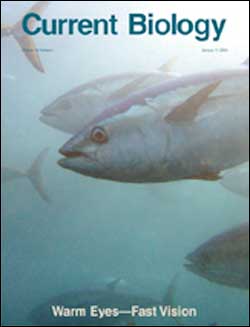Predator fish heat their eyes to track prey

Large and powerful predators such as swordfishes, tunas, and many sharks are unique among fishes in that they possess physiological mechanisms that warm their eyes. A new investigation reported this week sheds important light on the purpose of warming the eyes and the advantage that “warm eyes” confer on ocean predators.
Swordfishes, which hunt in water as cold as 3°C (about 37°F), can maintain their brain and eye temperatures 10°C–15°C (18°F –27°F) above ambient temperatures by using a specially adapted heating organ in muscle next to their eyes. The biological significance of this has been a mystery. Now, however, innovative research has shown that warm eyes allow swordfishes to process visual information more than 10 times more quickly than eyes cooled to the temperatures of deep-water environments.
Ship-board experiments by Kerstin Fritsches of the University of Queensland, Richard Brill of the National Marine Fisheries Service, and Eric Warrant of the University of Lund focused on electroretinogram recordings of freshly caught swordfishes. These established that higher eye temperatures maintain the speed of the retina’s response to stimuli. Using temperatures and light intensities aligned with swordfishes’ dive profiles, the team showed that by heating their eyes, swordfishes retain the ability to spot quickly moving objects, allowing them to intercept rapid and elusive prey.
These findings offer a fascinating view into how an evolutionary “arms race” has led to a sensory specialization that gives a predator a significant edge over its prey.
Media Contact
All latest news from the category: Life Sciences and Chemistry
Articles and reports from the Life Sciences and chemistry area deal with applied and basic research into modern biology, chemistry and human medicine.
Valuable information can be found on a range of life sciences fields including bacteriology, biochemistry, bionics, bioinformatics, biophysics, biotechnology, genetics, geobotany, human biology, marine biology, microbiology, molecular biology, cellular biology, zoology, bioinorganic chemistry, microchemistry and environmental chemistry.
Newest articles

Magnetic Effect: Groundbreaking Discovery for Low-Temperature Thermoelectric Cooling
Researchers at the Max Planck Institute for Chemical Physics of Solids, in collaboration with Chongqing University and the Max Planck Institute of Microstructure Physics, have achieved a breakthrough in topological…

Parallel Paths: Understanding Malaria Resistance in Chimpanzees and Humans
The closest relatives of humans adapt genetically to habitats and infections Survival of the Fittest: Genetic Adaptations Uncovered in Chimpanzees Görlitz, 10.01.2025. Chimpanzees have genetic adaptations that help them survive…

You are What You Eat—Stanford Study Links Fiber to Anti-Cancer Gene Modulation
The Fiber Gap: A Growing Concern in American Diets Fiber is well known to be an important part of a healthy diet, yet less than 10% of Americans eat the minimum recommended…



